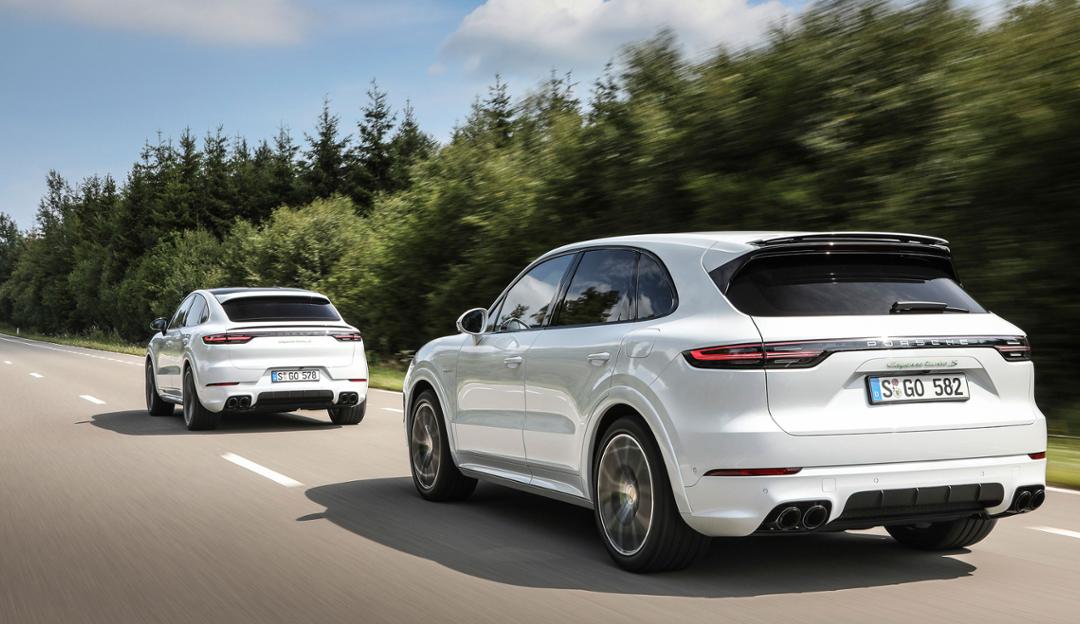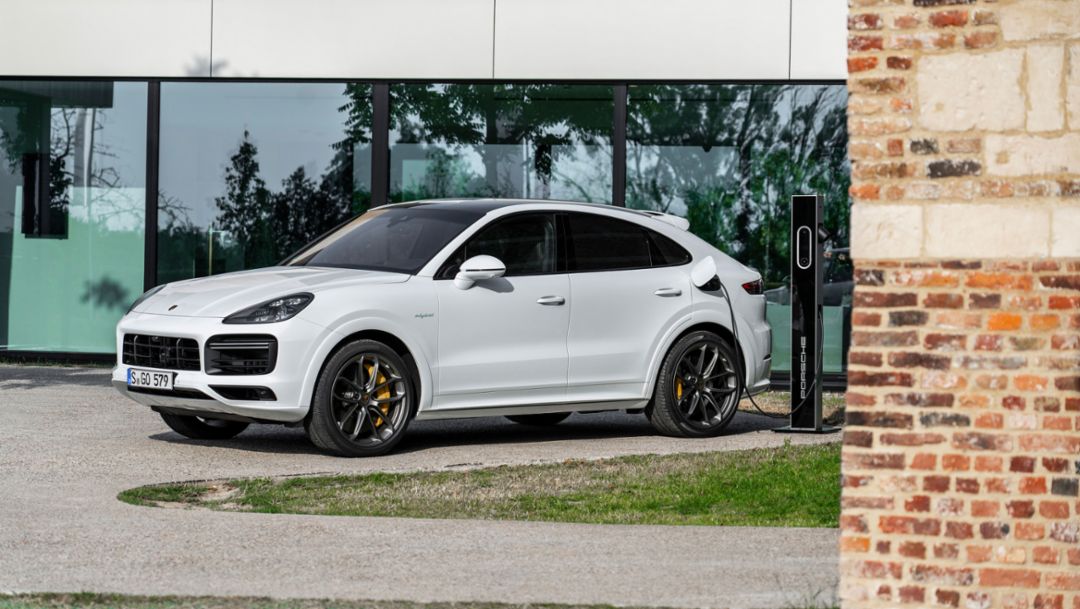The Cayenne Turbo S E-Hybrid and the Cayenne Turbo S E-Hybrid Coupé draw their system output of 500 kW (680 PS; Cayenne Turbo S E-Hybrid: Fuel consumption combined 3.9–3.7 l/100 km, electricity consumption 19.6–18.7 kWh/100 km, CO2 emissions combined 90–85 g/km; Cayenne Turbo S E-Hybrid Coupé: Fuel consumption combined 3.9–3.7 l/100 km, electricity consumption 19.6–18.7 kWh/100 km, CO2 emissions combined 90–85 g/km) from the intelligent interaction of a four-litre V8 engine (404 kW/550 PS) and an electric motor integrated into the eight-speed Tiptronic S transmission (100 kW/136 PS). The maximum system torque of 900 Nm is available from just above idle. Both models accelerate from a standing start to 100 km/h in 3.8 seconds and reach a top speed of 295 km/h. This exceptional performance is matched by a high level of efficiency: the Cayenne Turbo S E-Hybrid and Turbo S E-Hybrid Coupé can drive for up to 40 kilometres with zero local emissions. The average NEDC consumption is 3.9–3.7 l/100 km (fuel) and 19.6–18.7 kWh/100 km (electric).
In addition to the two top models, the hybrid range from Porsche now includes the new Cayenne E-Hybrid Coupé with system power of 340 kW (462 PS; Fuel consumption combined 3.2–3.1 l/100 km, electricity consumption 18.7–17.7 kWh/100 km, CO2 emissions combined 75–72 g/km), torque of 700 Nm, and electric range of up to 43 kilometres. The Cayenne E-Hybrid, which now features a gasoline particulate filter, is available to order again.
Speeds of up to 135 km/h with just electric power
Like all Porsche plug-in hybrids, the new top-of-the-range model in the Cayenne family is also one of the sportiest vehicles in the premium segment – not in spite of its hybrid powertrain but because of it. In the Cayenne Turbo S E-Hybrid models, the electric motor is located between the V8 engine and the eight-speed Tiptronic S transmission. The two motors are interconnected via a separating clutch inside the hybrid module, referred to as the Electric Clutch Actuator (ECA). In E-Power driving mode, the electric motor can, on its own, propel the vehicle up to a maximum speed of 135 km/h. It can also be used in the other modes for an additional power boost. These modes can be selected via the standard Sport Chrono Package (Hybrid Auto, Sport and Sport Plus). Porsche has taken this boost strategy from the 918 Spyder super sports car.
The lithium-ion battery is installed underneath the loadspace floor and has a capacity of 14.1 kWh. The high-voltage battery can be fully charged within 2.4 hours with the standard 7.2 kW onboard AC charger when using a 400-volt connection with a 16-amp fuse. The charging process takes six hours from a conventional domestic socket with a rating of 230 volts and 10 amps. Charging can also be scheduled via Porsche Communication Management (PCM) or the Porsche Connect app (for smartphones and Apple® Watch).
Roll stabilisation system, air suspension, and ceramic brakes as standard
The Cayenne Turbo S E-Hybrid and the Cayenne Turbo S E-Hybrid Coupé come with extensive factory-fitted equipment as standard: features include the Porsche Dynamic Chassis Control (PDCC) electric roll stabilisation system, Porsche Torque Vectoring Plus (PTV Plus) rear-axle differential lock, the Porsche Ceramic Composite Brake (PCCB) high-performance brake system, 21-inch lightweight alloy wheels in Aero design including wheel arch extensions in body colour, Power Steering Plus, and the Sport Chrono Package. The adaptive three-chamber air suspension, including Porsche Active Suspension Management (PASM), ensures a broad spectrum of typical Porsche driving dynamics and a comfortable ride. Up to 22-inch lightweight alloy wheels and rear-axle steering are also available as optional extras.
Full connectivity and auxiliary air conditioning as standard
All Cayenne models include full connectivity as standard. This enables online navigation with real-time traffic information, smart online voice control, and extensive Porsche Connect services – including searching for public charging stations. Additional options for all Cayenne derivatives when the new model year starts include wireless Apple CarPlay®, new USB-C ports and a smartphone storage tray with inductive charging function. All hybrid models from Porsche have auxiliary air conditioning as standard. This can be remote-controlled directly via the PCM and via the Porsche Connect app, and enables the vehicle to be heated and cooled even when the ignition is not switched on.
All Cayenne models feature LED headlights, a cruise control system with speed limiter function, camera-based pedestrian protection and Park Assist at the front and rear – including a rear-view camera system in the Cayenne Coupé. Optional extras include LED matrix beam headlights, a head-up display, Night Vision with thermal imaging camera, and the Porsche InnoDrive digital co-pilot including adaptive cruise control, lane keeping assist, road sign recognition, active lane guidance, junction assistant and emergency braking.
A double debut: Cayenne Coupé as a V6 and V8 hybrid
With the Cayenne Coupé, Porsche has added an even sportier variant to its successful SUV line-up. Highlights of the coupé include sharper lines with a unique roof and rear section, an adaptive rear spoiler, a rear seat bench with the characteristics of two individual seats, and two different roof designs: a panoramic fixed glass roof as standard and an optional carbon roof. Like the SUV, the SUV coupé is now available in two different hybrid versions: in combination with the 4.0-litre V8 biturbo engine and with a 3.0-litre V6 turbo engine. The new Cayenne E-Hybrid Coupé has a system output of 340 kW (462 PS) and a system torque of 700 Nm. In conjunction with the standard Sport Chrono Package, it sprints from a standing start to 100 km/h in 5.1 seconds
(5.0 seconds with the lightweight sports packages) and has a top speed of 253 km/h. The average consumption according to the New European Driving Cycle (NEDC) is 3.2–3.1 l/100 km (fuel) and 18.7 – 17.7 kWh/100 km (electric). The purely electric range is up to 43 kilometres.
All four different hybrid versions of the Cayenne are now available to order.






